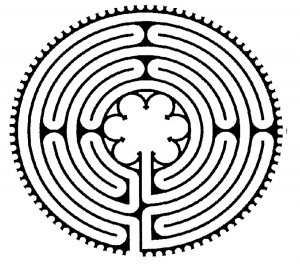
The Labyrinth at the Roseburg First United Methodist Church
1771 W. Harvard
What Is A Labyrinth?
Part of human history for more than 4000 years. Labyrinths are found in almost every culture and every religious tradition around the world. A labyrinth is not a maze. Mazes have multiple paths and multiple choices, mostly leading nowhere specific. A labyrinth has only one path that leads circuitously to the center. The same pathway leads one out again.
The labyrinth located adjacent to the First United Methodist Church is a traditional design patterned after the labyrinth at Chartres Cathedral, Chartres, France. The overall design is based on a 13-point star. While the path is intricate and contains many turns, it never crosses itself. It has 11 rings from the outer edge to the center. The center has six petals. The petals can symbolize the six days of creation, or the six levels of evolution in Christian theology: mineral, plant, animal, human, angelic, divine. The center, called the “rosette” is a place of rest. Overall, the fundamentally circular shape symbolizes wholeness and completion. The labyrinth gets its name from the cross (or double axe) pattern that is formed by the “labyrs.” They are created by the 180-degree turns in the path. The outer edge of the labyrinth is made of scalloped edges called “lunations,” containing cusps or points.
Why walk a labyrinth
A labyrinth is an ancient symbol related to wholeness. It combines the imagery of the circle and the spiral into a purposeful path. The Labyrinth represents a journey to our center and back again out into the world. It has a long history as a meditation and prayer tool in many cultures. It is not a maze. Mazes have multiple paths and choices, some leading nowhere. A labyrinth has only one path that leads to the center. The same pathway leads one out again. The labyrinth invites us to slow down and become more aware.
In our hectic world, the labyrinth helps us address many psychological and spiritual areas of life. The path is helpful in bringing calm in our hectic lives, integrating our mind, body, and spirit, and awakening our spirituality.
Some benefits of Walking a Labyrinth
- Reduces stress.
- Helps quiet the mind.
- Opens the heart.
- Promotes the interaction of mind, body, and spirit.
- Fosters creativity.
- Provides a walking meditation.
- Promotes wellness.
- Increases self-awareness.
- Promotes spiritual growth.
- Provides a right and left brain activity.
A Purposeful Path
The labyrinth provides a purposeful path that meanders at your perfect pace to the center and provides physical, psychological, and spiritual benefits. Labyrinths can be a walking meditation and are often seen as a metaphor of our life. The walking becomes a meditation when it includes reflection and problem solving related to daily issues in our life.
For many, walking a labyrinth represents a metaphor for life’s journey. The twists and turns of the labyrinth represent the ups and downs, the uncertainties, and the discoveries encountered in life. For others it may serve as a tool to foster a deeper connection with a higher power or the divine, enabling spiritual growth and a sense of wholeness. For everyone it can relieve stress and worry.
To prepare yourself to walk the labyrinth, pause and take a few moments to quiet your mind and become aware of your breathing. As you begin walking, allow yourself to find the walking pace your body wants to go. Do what feels natural.
Most of all: Enjoy!
How to walk a labyrinth
There is a big difference in walking a maze and walking a labyrinth. When one walks a maze there is confusion involved. There are many pathways and many dead ends. When one walks a labyrinth there is no confusion and there is only one pathway to a specific center and one pathway out. Kern (2000) says: “In a maze we lose ourselves, in a labyrinth we find ourselves.”
There is no right way to walk a labyrinth. You need only enter and follow the path. However, your walk can encompass a variety of attitudes. It may be joyous or somber. It might be thoughtful or prayerful. You may use it as a walking meditation. Adults are often serious when walking a labyrinth. Children are more likely to run in and out as fast as they can. When you walk a labyrinth, you can choose your attitude. Experiment with different attitudes. Make it playful, serious, or prayerful. If you are alone in the labyrinth you may want to play music or sing or pray out loud. If others are present, you may want to be more considerate of their needs and progress quietly. In either case you can notice the sky, listen to the sounds, and most importantly, focus on your experience.
When walking the labyrinth at the same time as others, you may want to pause at the entrance to allow the person before you to get a little way into the labyrinth before you start. Walk at your own pace. You may “pass” people or let others step around you. This is easiest at the turns. With labyrinths, the way in is the way out. Your may meet people going either direction.
Once you have reached the center of the labyrinth you can stay as long as seems appropriate to you. This is a place of meditation and prayer. You may want to pray, listen, relax, or think before walking the path back out.
Some general guidelines for walking a labyrinth
- Focus-Pause and wait a moment at the entrance. Become quiet and centered.
- Experience-Walk purposefully. Observe the process. When you reach the center, stay there and focus for several moments. You may use each petal to focus on a different aspect of your life: health, family, work, relationships, stress, something heavy on your heart, etc. Leave when it feels appropriate. Be attentive on the way out.
- Exit-Turn and face the entrance. Give an acknowledgement of ending, such as “Amen.”
- Reflect-After walking the labyrinth reflect on your experience. Use journaling, drawing, or a photo to capture your experience.
- Walk frequently-You will gain more as you become more experienced at focusing, experiencing, and reflecting.
The Threefold Path
There are many approaches to using a labyrinth. One Christian based approach is to focus on the “threefold path” of Purgation, Illumination and Union (Artress, 2006). These represent three stages in a labyrinth walk.
- Releasing (Purgation)-From the entrance as you move toward the center, the goal is to shed or “let go.” There is a release and emptying of worries and concerns.
- Receiving (Illumination)-At the center open yourself to some form of illumination such as clarity, focus, or insight. This is where you can focus on the six aspects of life.
- Integrating (Union)-The path out is that of becoming grounded and integrating the insight. It is being energized, empowered, and taking ownership. It is the time to prepare to make what was received manifest in the world.
Palms Down, Palms Up
A “Palms Down, Palms Up” approach to walking the labyrinth can be used to both represent and facilitate these three stages. Turning your palms down symbolizes releasing or letting go. Turn palms up indicates receiving.
You may want to enter the labyrinth and walk to the center with palms down and center your thoughts on releasing issues and concerns in your life. When you reach the center turn your palms up to be receptive to insight. As you walk out of the labyrinth keep your palms up to receive strength and guidance to put your insight into practice. As you leave the labyrinth, you may want to turn to face the center and bring your palms together for a prayerful end to your walk.
Suggestions for your walk:
- Quiet your mind and become aware of your breathing.
- Enter and follow the path. If there are others ahead of you, allow them to progress part way through the labyrinth before you enter. Go at your own pace. Hold your palms down.
- If you meet others, pass them quietly. This is easiest at the turns.
- As you reach the center, seek openness and peacefulness so you may receive what the moment offers you. Stay as long as you feel the need. Turn your palms up.
- As you leave, reflect on your experience and how it may apply to your life.
- Go in peace.
References
- Kern. (2000). Through the Labyrinth: Designs and Meanings Over 5000 Years. London: Prestel Publishing
L. Artress. (2006). Walking a Sacred Path: Rediscovering the Labyrinth as a Spiritual Tool. Ney York, NY: Riverhead Books
